Economics Assignment: Externalities, Elasticity, and Market Analysis
VerifiedAdded on 2023/04/20
|16
|2297
|441
Homework Assignment
AI Summary
This economics assignment delves into several key concepts within the field. It begins by examining the impact of external costs and benefits on resource allocation, exploring how these externalities lead to market inefficiencies. The assignment then explores elasticity of demand, calculating price elasticity and analyzing its implications on total revenue. Further, it analyzes the characteristics of public and private goods. The assignment also covers cost analysis, differentiating between fixed and variable costs, and calculating average and marginal costs. Finally, it compares allocative efficiency in perfectly competitive markets and monopolies, and analyzes the effects of various market changes such as changes in supply and demand. The assignment provides a comprehensive analysis of these topics, offering a solid foundation in microeconomic principles. This document is contributed by a student to be published on the website Desklib, a platform which provides all the necessary AI based study tools for students.
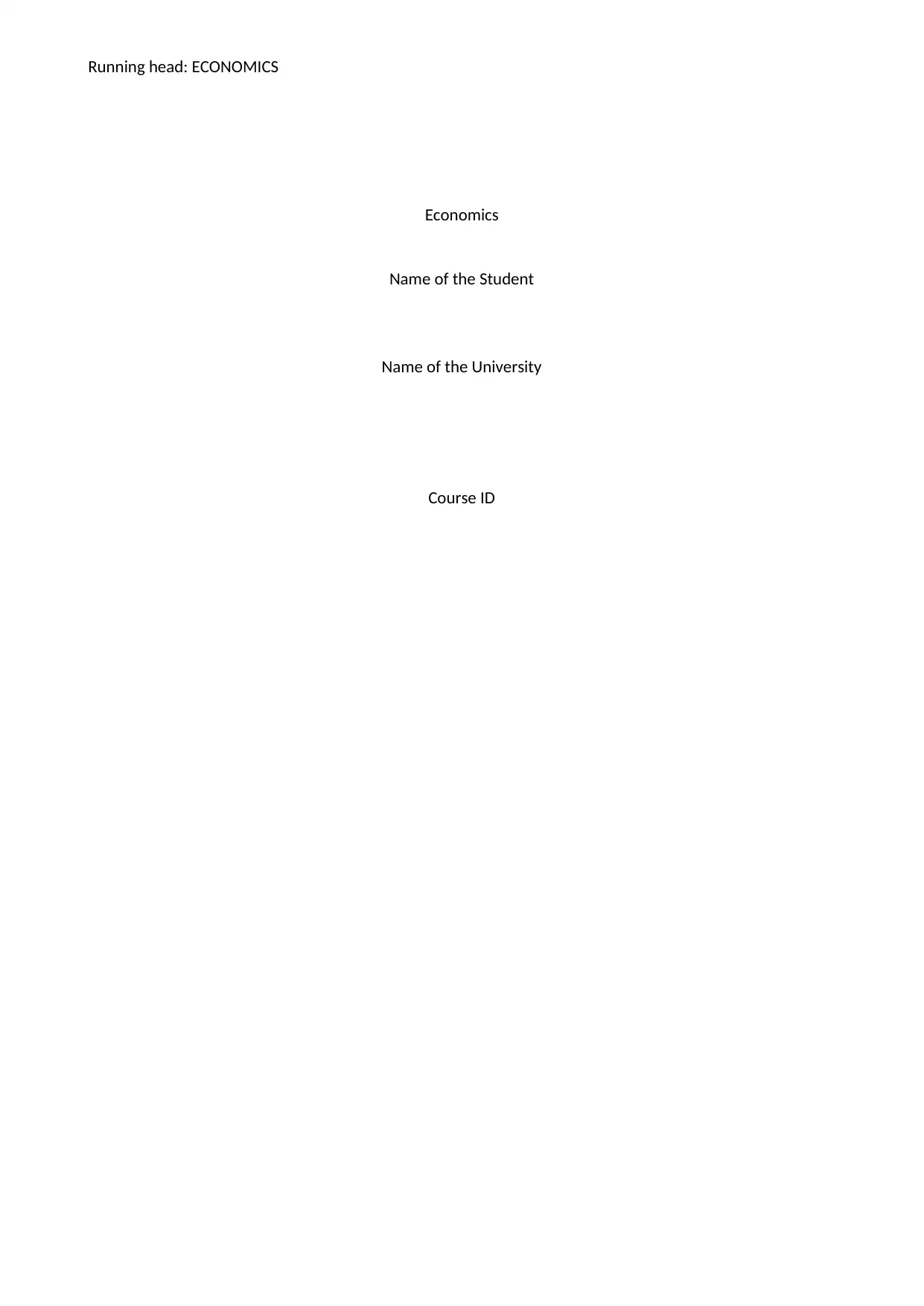
Running head: ECONOMICS
Economics
Name of the Student
Name of the University
Course ID
Economics
Name of the Student
Name of the University
Course ID
Paraphrase This Document
Need a fresh take? Get an instant paraphrase of this document with our AI Paraphraser
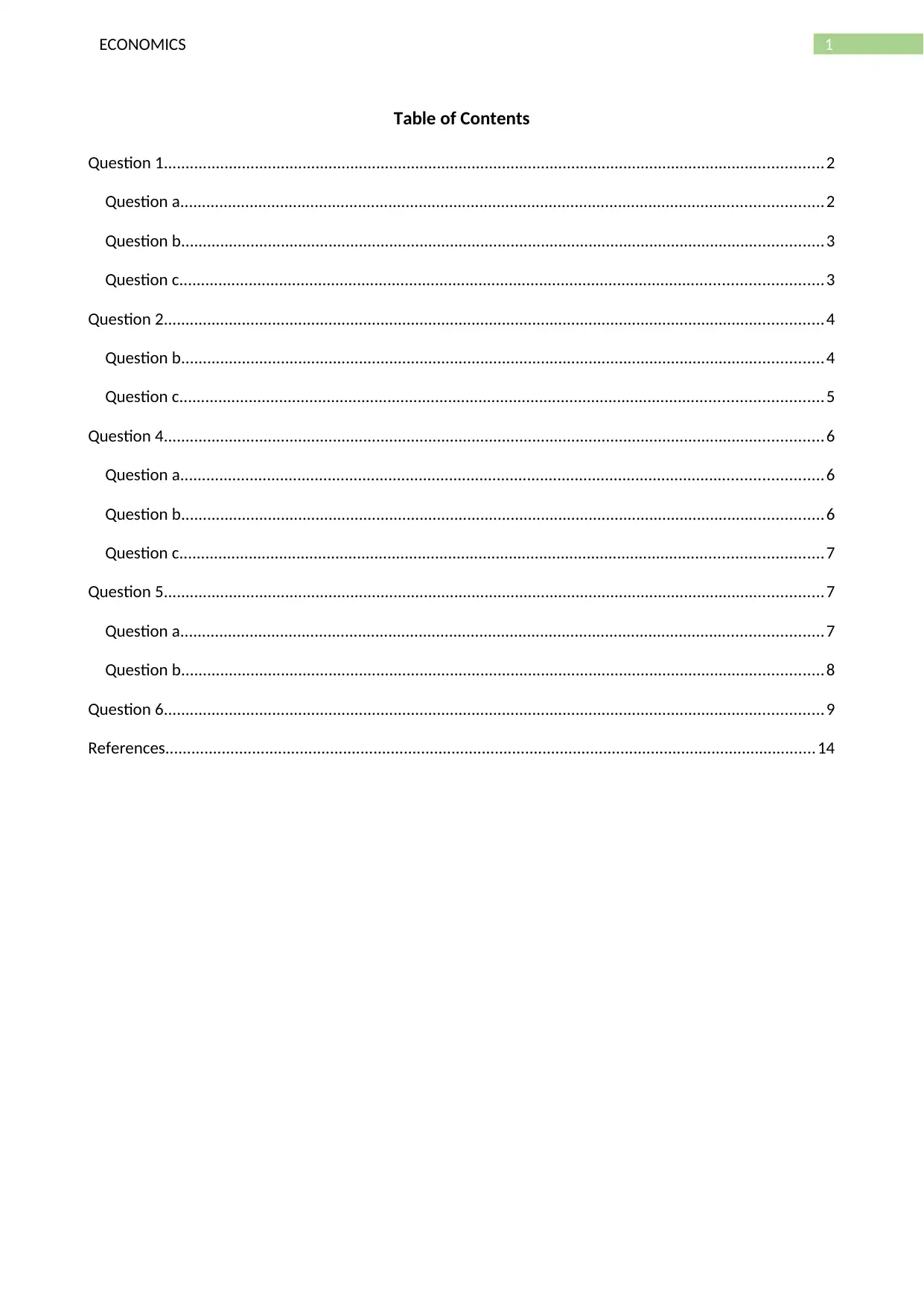
1ECONOMICS
Table of Contents
Question 1........................................................................................................................................................2
Question a....................................................................................................................................................2
Question b....................................................................................................................................................3
Question c....................................................................................................................................................3
Question 2........................................................................................................................................................4
Question b....................................................................................................................................................4
Question c....................................................................................................................................................5
Question 4........................................................................................................................................................6
Question a....................................................................................................................................................6
Question b....................................................................................................................................................6
Question c....................................................................................................................................................7
Question 5........................................................................................................................................................7
Question a....................................................................................................................................................7
Question b....................................................................................................................................................8
Question 6........................................................................................................................................................9
References......................................................................................................................................................14
Table of Contents
Question 1........................................................................................................................................................2
Question a....................................................................................................................................................2
Question b....................................................................................................................................................3
Question c....................................................................................................................................................3
Question 2........................................................................................................................................................4
Question b....................................................................................................................................................4
Question c....................................................................................................................................................5
Question 4........................................................................................................................................................6
Question a....................................................................................................................................................6
Question b....................................................................................................................................................6
Question c....................................................................................................................................................7
Question 5........................................................................................................................................................7
Question a....................................................................................................................................................7
Question b....................................................................................................................................................8
Question 6........................................................................................................................................................9
References......................................................................................................................................................14
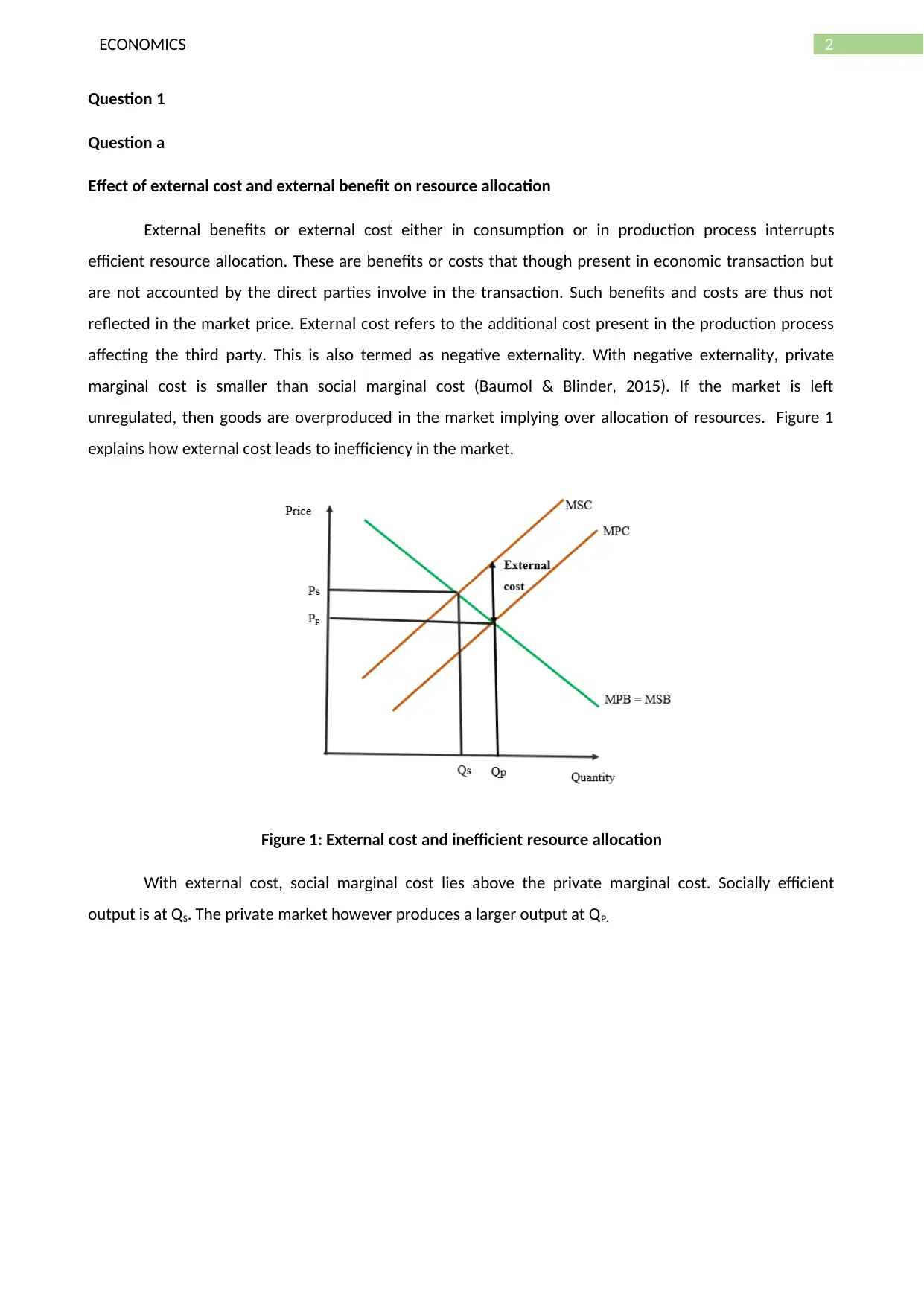
2ECONOMICS
Question 1
Question a
Effect of external cost and external benefit on resource allocation
External benefits or external cost either in consumption or in production process interrupts
efficient resource allocation. These are benefits or costs that though present in economic transaction but
are not accounted by the direct parties involve in the transaction. Such benefits and costs are thus not
reflected in the market price. External cost refers to the additional cost present in the production process
affecting the third party. This is also termed as negative externality. With negative externality, private
marginal cost is smaller than social marginal cost (Baumol & Blinder, 2015). If the market is left
unregulated, then goods are overproduced in the market implying over allocation of resources. Figure 1
explains how external cost leads to inefficiency in the market.
Figure 1: External cost and inefficient resource allocation
With external cost, social marginal cost lies above the private marginal cost. Socially efficient
output is at QS. The private market however produces a larger output at QP.
Question 1
Question a
Effect of external cost and external benefit on resource allocation
External benefits or external cost either in consumption or in production process interrupts
efficient resource allocation. These are benefits or costs that though present in economic transaction but
are not accounted by the direct parties involve in the transaction. Such benefits and costs are thus not
reflected in the market price. External cost refers to the additional cost present in the production process
affecting the third party. This is also termed as negative externality. With negative externality, private
marginal cost is smaller than social marginal cost (Baumol & Blinder, 2015). If the market is left
unregulated, then goods are overproduced in the market implying over allocation of resources. Figure 1
explains how external cost leads to inefficiency in the market.
Figure 1: External cost and inefficient resource allocation
With external cost, social marginal cost lies above the private marginal cost. Socially efficient
output is at QS. The private market however produces a larger output at QP.
⊘ This is a preview!⊘
Do you want full access?
Subscribe today to unlock all pages.

Trusted by 1+ million students worldwide
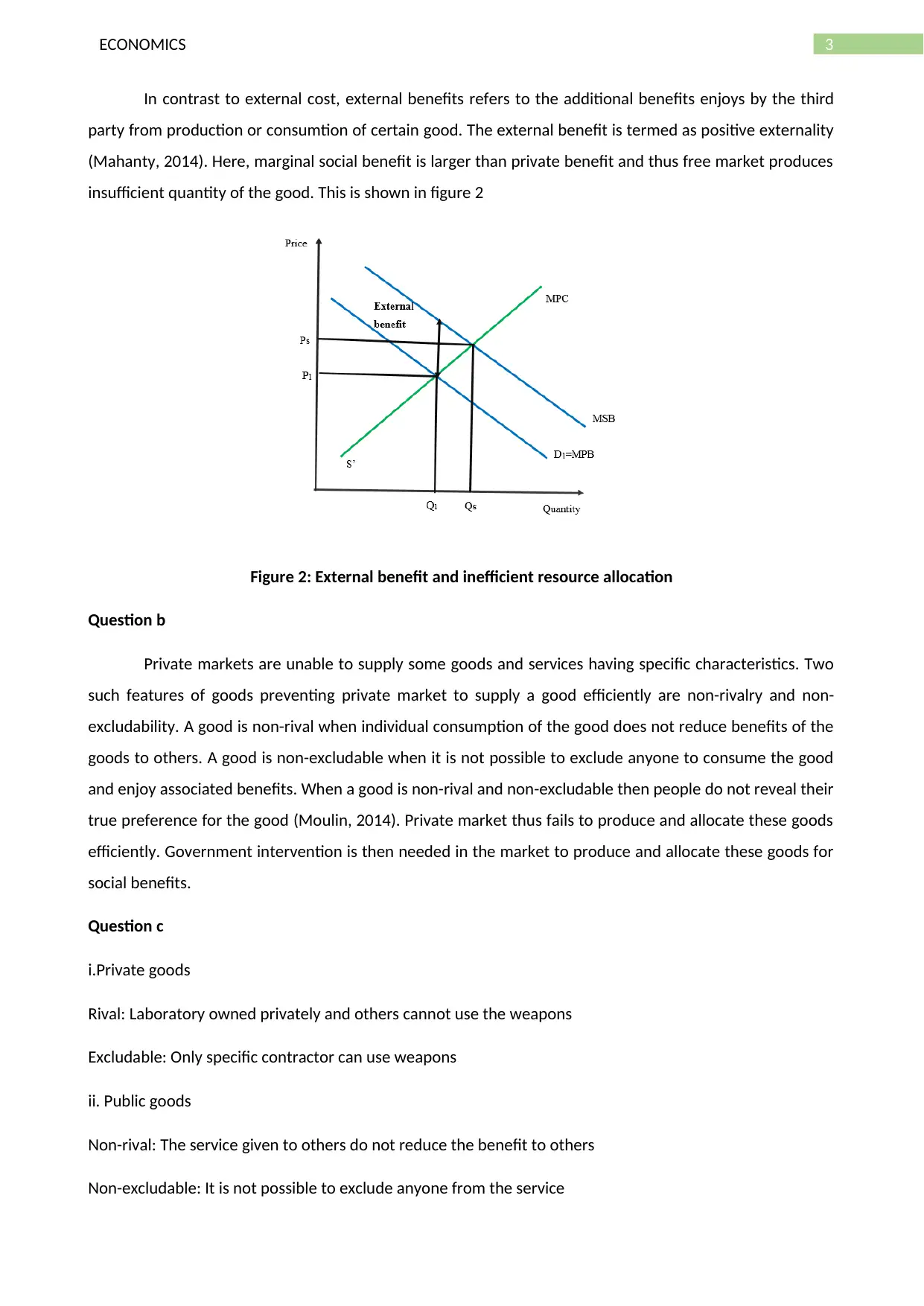
3ECONOMICS
In contrast to external cost, external benefits refers to the additional benefits enjoys by the third
party from production or consumtion of certain good. The external benefit is termed as positive externality
(Mahanty, 2014). Here, marginal social benefit is larger than private benefit and thus free market produces
insufficient quantity of the good. This is shown in figure 2
Figure 2: External benefit and inefficient resource allocation
Question b
Private markets are unable to supply some goods and services having specific characteristics. Two
such features of goods preventing private market to supply a good efficiently are non-rivalry and non-
excludability. A good is non-rival when individual consumption of the good does not reduce benefits of the
goods to others. A good is non-excludable when it is not possible to exclude anyone to consume the good
and enjoy associated benefits. When a good is non-rival and non-excludable then people do not reveal their
true preference for the good (Moulin, 2014). Private market thus fails to produce and allocate these goods
efficiently. Government intervention is then needed in the market to produce and allocate these goods for
social benefits.
Question c
i.Private goods
Rival: Laboratory owned privately and others cannot use the weapons
Excludable: Only specific contractor can use weapons
ii. Public goods
Non-rival: The service given to others do not reduce the benefit to others
Non-excludable: It is not possible to exclude anyone from the service
In contrast to external cost, external benefits refers to the additional benefits enjoys by the third
party from production or consumtion of certain good. The external benefit is termed as positive externality
(Mahanty, 2014). Here, marginal social benefit is larger than private benefit and thus free market produces
insufficient quantity of the good. This is shown in figure 2
Figure 2: External benefit and inefficient resource allocation
Question b
Private markets are unable to supply some goods and services having specific characteristics. Two
such features of goods preventing private market to supply a good efficiently are non-rivalry and non-
excludability. A good is non-rival when individual consumption of the good does not reduce benefits of the
goods to others. A good is non-excludable when it is not possible to exclude anyone to consume the good
and enjoy associated benefits. When a good is non-rival and non-excludable then people do not reveal their
true preference for the good (Moulin, 2014). Private market thus fails to produce and allocate these goods
efficiently. Government intervention is then needed in the market to produce and allocate these goods for
social benefits.
Question c
i.Private goods
Rival: Laboratory owned privately and others cannot use the weapons
Excludable: Only specific contractor can use weapons
ii. Public goods
Non-rival: The service given to others do not reduce the benefit to others
Non-excludable: It is not possible to exclude anyone from the service
Paraphrase This Document
Need a fresh take? Get an instant paraphrase of this document with our AI Paraphraser
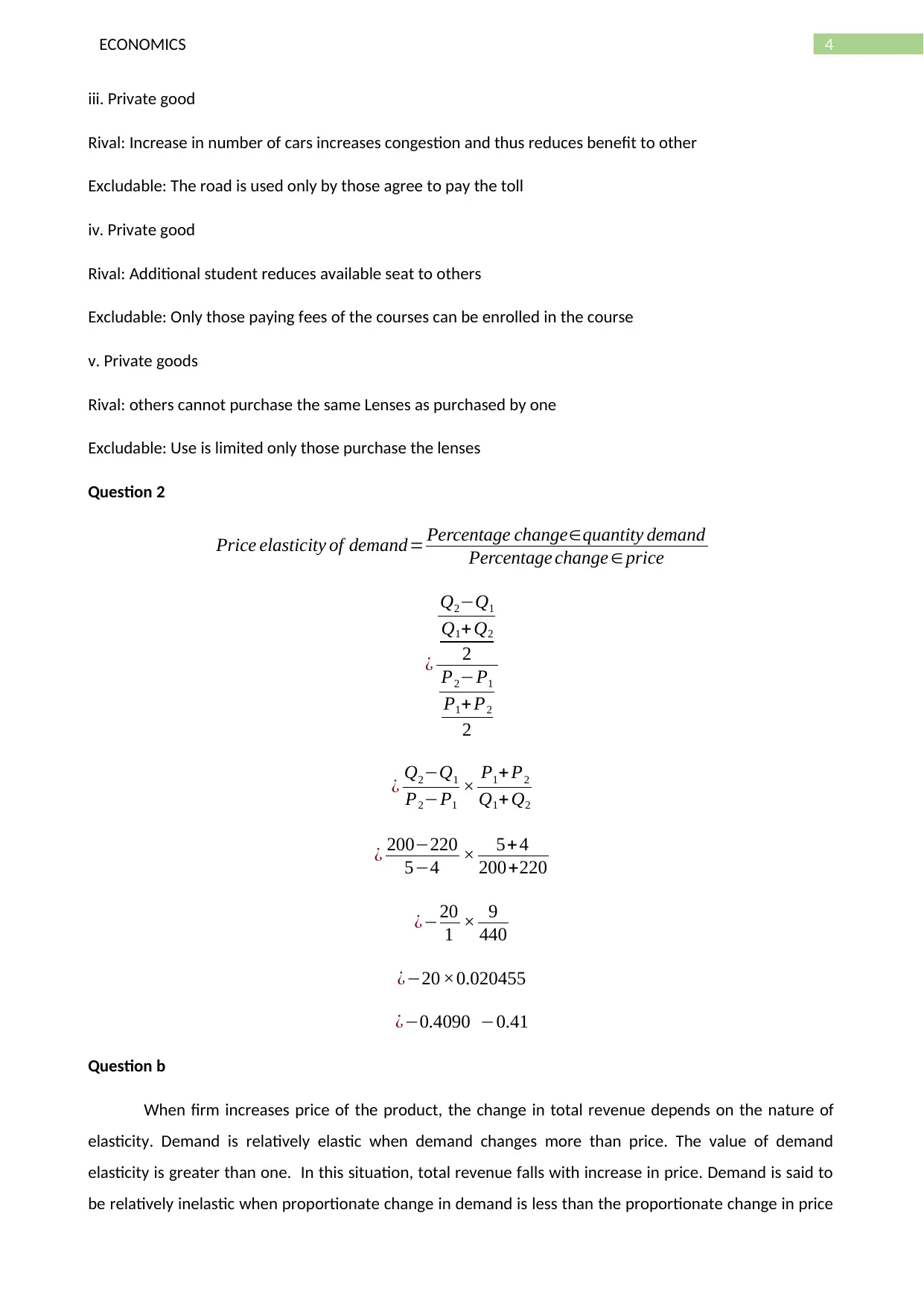
4ECONOMICS
iii. Private good
Rival: Increase in number of cars increases congestion and thus reduces benefit to other
Excludable: The road is used only by those agree to pay the toll
iv. Private good
Rival: Additional student reduces available seat to others
Excludable: Only those paying fees of the courses can be enrolled in the course
v. Private goods
Rival: others cannot purchase the same Lenses as purchased by one
Excludable: Use is limited only those purchase the lenses
Question 2
Price elasticity of demand= Percentage change∈quantity demand
Percentage change ∈ price
¿
Q2−Q1
Q1+ Q2
2
P2−P1
P1+ P2
2
¿ Q2−Q1
P2−P1
× P1+ P2
Q1+ Q2
¿ 200−220
5−4 × 5+ 4
200+220
¿−20
1 × 9
440
¿−20 ×0.020455
¿−0.4090 −0.41
Question b
When firm increases price of the product, the change in total revenue depends on the nature of
elasticity. Demand is relatively elastic when demand changes more than price. The value of demand
elasticity is greater than one. In this situation, total revenue falls with increase in price. Demand is said to
be relatively inelastic when proportionate change in demand is less than the proportionate change in price
iii. Private good
Rival: Increase in number of cars increases congestion and thus reduces benefit to other
Excludable: The road is used only by those agree to pay the toll
iv. Private good
Rival: Additional student reduces available seat to others
Excludable: Only those paying fees of the courses can be enrolled in the course
v. Private goods
Rival: others cannot purchase the same Lenses as purchased by one
Excludable: Use is limited only those purchase the lenses
Question 2
Price elasticity of demand= Percentage change∈quantity demand
Percentage change ∈ price
¿
Q2−Q1
Q1+ Q2
2
P2−P1
P1+ P2
2
¿ Q2−Q1
P2−P1
× P1+ P2
Q1+ Q2
¿ 200−220
5−4 × 5+ 4
200+220
¿−20
1 × 9
440
¿−20 ×0.020455
¿−0.4090 −0.41
Question b
When firm increases price of the product, the change in total revenue depends on the nature of
elasticity. Demand is relatively elastic when demand changes more than price. The value of demand
elasticity is greater than one. In this situation, total revenue falls with increase in price. Demand is said to
be relatively inelastic when proportionate change in demand is less than the proportionate change in price
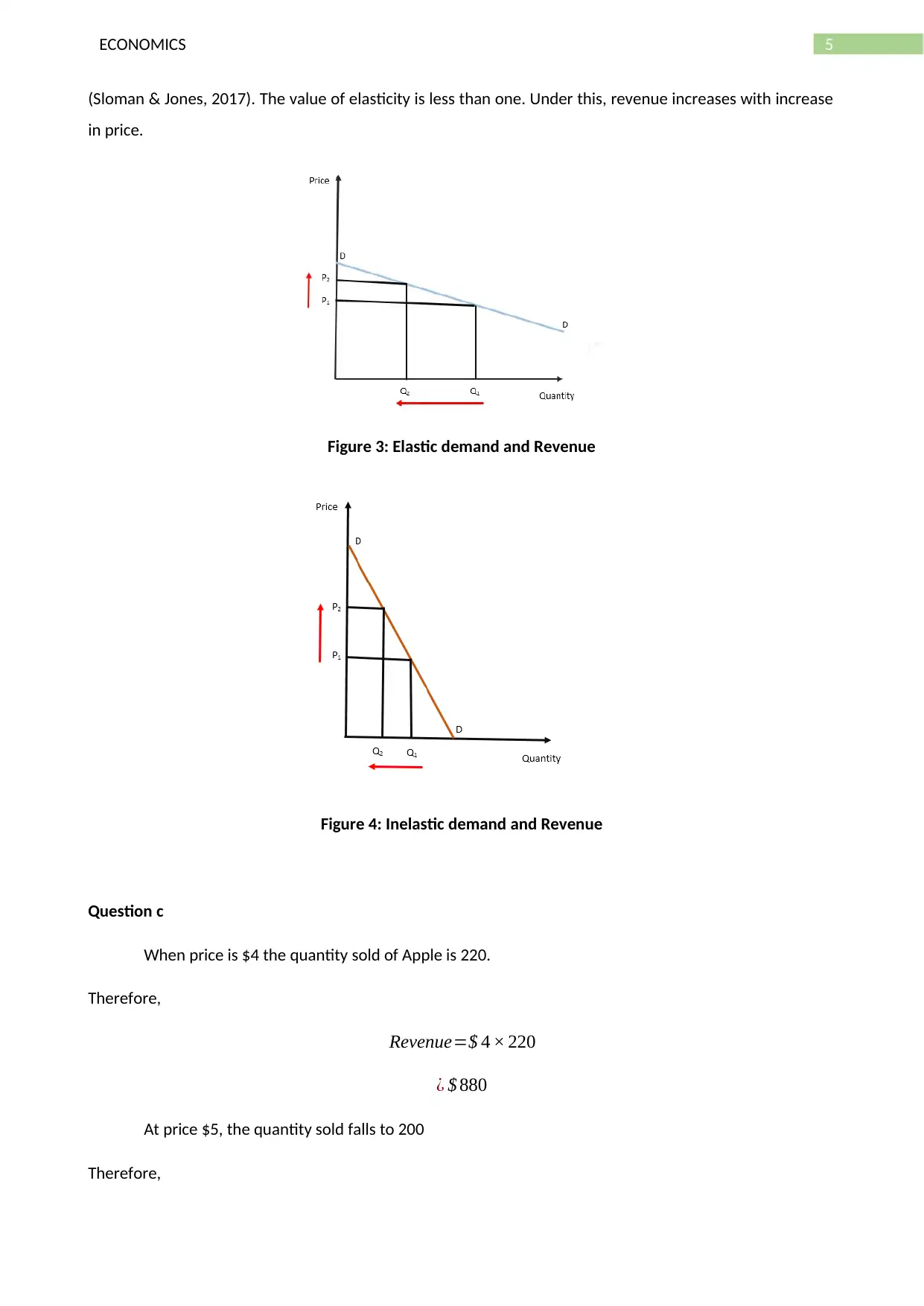
5ECONOMICS
(Sloman & Jones, 2017). The value of elasticity is less than one. Under this, revenue increases with increase
in price.
Figure 3: Elastic demand and Revenue
Figure 4: Inelastic demand and Revenue
Question c
When price is $4 the quantity sold of Apple is 220.
Therefore,
Revenue=$ 4 × 220
¿ $ 880
At price $5, the quantity sold falls to 200
Therefore,
(Sloman & Jones, 2017). The value of elasticity is less than one. Under this, revenue increases with increase
in price.
Figure 3: Elastic demand and Revenue
Figure 4: Inelastic demand and Revenue
Question c
When price is $4 the quantity sold of Apple is 220.
Therefore,
Revenue=$ 4 × 220
¿ $ 880
At price $5, the quantity sold falls to 200
Therefore,
⊘ This is a preview!⊘
Do you want full access?
Subscribe today to unlock all pages.

Trusted by 1+ million students worldwide
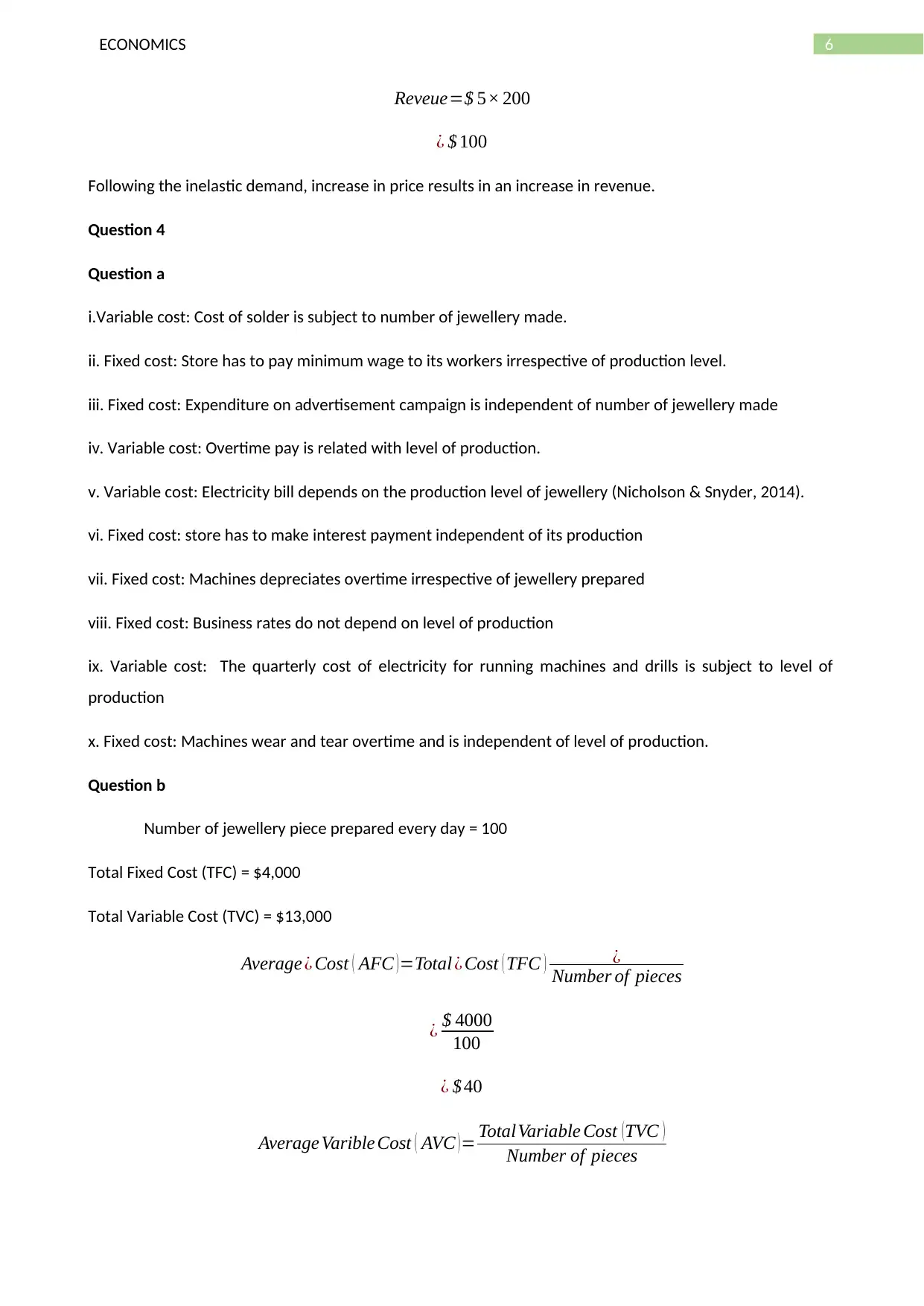
6ECONOMICS
Reveue=$ 5× 200
¿ $ 100
Following the inelastic demand, increase in price results in an increase in revenue.
Question 4
Question a
i.Variable cost: Cost of solder is subject to number of jewellery made.
ii. Fixed cost: Store has to pay minimum wage to its workers irrespective of production level.
iii. Fixed cost: Expenditure on advertisement campaign is independent of number of jewellery made
iv. Variable cost: Overtime pay is related with level of production.
v. Variable cost: Electricity bill depends on the production level of jewellery (Nicholson & Snyder, 2014).
vi. Fixed cost: store has to make interest payment independent of its production
vii. Fixed cost: Machines depreciates overtime irrespective of jewellery prepared
viii. Fixed cost: Business rates do not depend on level of production
ix. Variable cost: The quarterly cost of electricity for running machines and drills is subject to level of
production
x. Fixed cost: Machines wear and tear overtime and is independent of level of production.
Question b
Number of jewellery piece prepared every day = 100
Total Fixed Cost (TFC) = $4,000
Total Variable Cost (TVC) = $13,000
Average ¿ Cost ( AFC ) =Total ¿ Cost ( TFC ) ¿
Number of pieces
¿ $ 4000
100
¿ $ 40
Average Varible Cost ( AVC ) = TotalVariable Cost ( TVC )
Number of pieces
Reveue=$ 5× 200
¿ $ 100
Following the inelastic demand, increase in price results in an increase in revenue.
Question 4
Question a
i.Variable cost: Cost of solder is subject to number of jewellery made.
ii. Fixed cost: Store has to pay minimum wage to its workers irrespective of production level.
iii. Fixed cost: Expenditure on advertisement campaign is independent of number of jewellery made
iv. Variable cost: Overtime pay is related with level of production.
v. Variable cost: Electricity bill depends on the production level of jewellery (Nicholson & Snyder, 2014).
vi. Fixed cost: store has to make interest payment independent of its production
vii. Fixed cost: Machines depreciates overtime irrespective of jewellery prepared
viii. Fixed cost: Business rates do not depend on level of production
ix. Variable cost: The quarterly cost of electricity for running machines and drills is subject to level of
production
x. Fixed cost: Machines wear and tear overtime and is independent of level of production.
Question b
Number of jewellery piece prepared every day = 100
Total Fixed Cost (TFC) = $4,000
Total Variable Cost (TVC) = $13,000
Average ¿ Cost ( AFC ) =Total ¿ Cost ( TFC ) ¿
Number of pieces
¿ $ 4000
100
¿ $ 40
Average Varible Cost ( AVC ) = TotalVariable Cost ( TVC )
Number of pieces
Paraphrase This Document
Need a fresh take? Get an instant paraphrase of this document with our AI Paraphraser
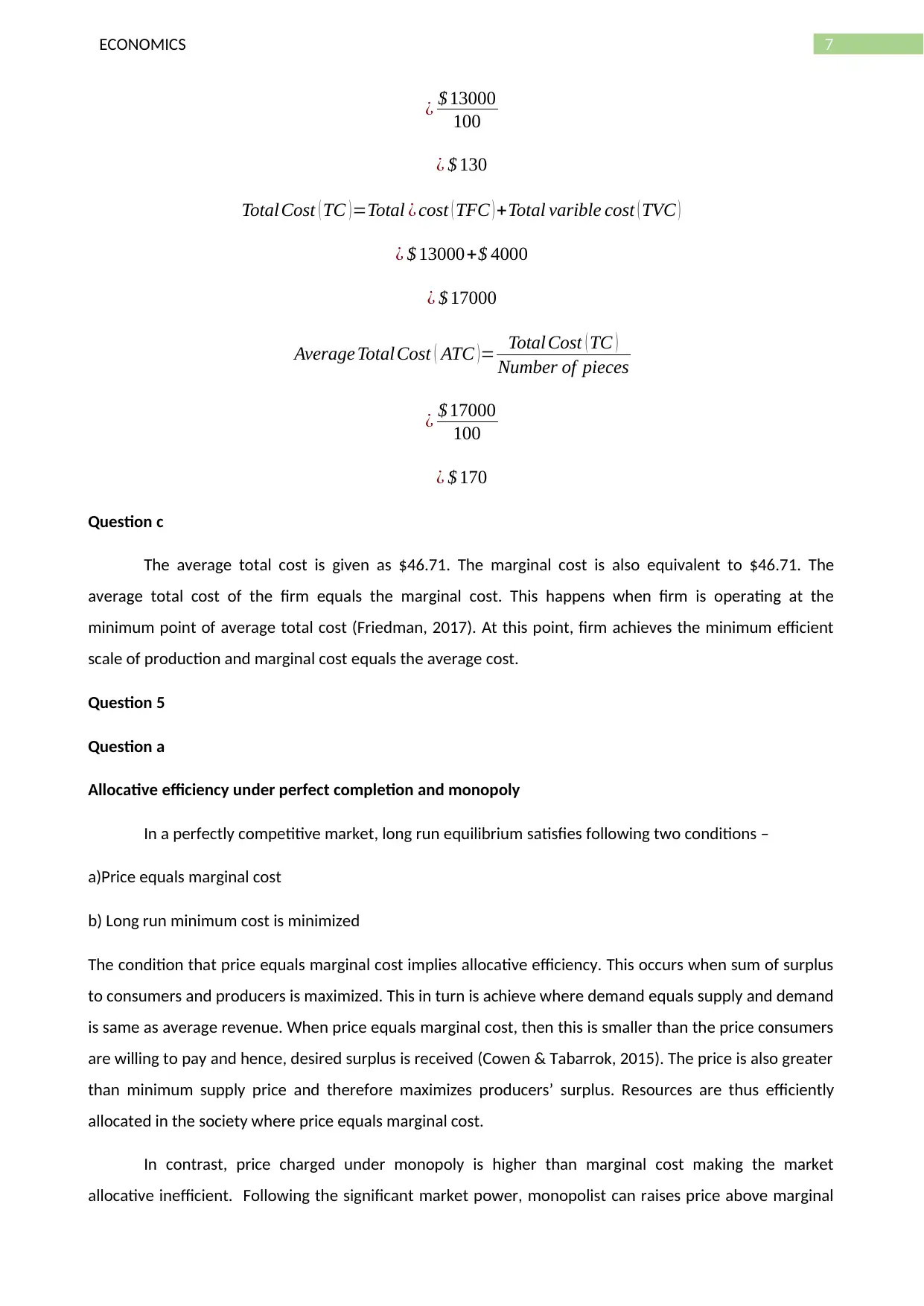
7ECONOMICS
¿ $ 13000
100
¿ $ 130
Total Cost ( TC )=Total ¿ cost ( TFC ) +Total varible cost ( TVC )
¿ $ 13000+$ 4000
¿ $ 17000
Average Total Cost ( ATC ) = Total Cost ( TC )
Number of pieces
¿ $ 17000
100
¿ $ 170
Question c
The average total cost is given as $46.71. The marginal cost is also equivalent to $46.71. The
average total cost of the firm equals the marginal cost. This happens when firm is operating at the
minimum point of average total cost (Friedman, 2017). At this point, firm achieves the minimum efficient
scale of production and marginal cost equals the average cost.
Question 5
Question a
Allocative efficiency under perfect completion and monopoly
In a perfectly competitive market, long run equilibrium satisfies following two conditions –
a)Price equals marginal cost
b) Long run minimum cost is minimized
The condition that price equals marginal cost implies allocative efficiency. This occurs when sum of surplus
to consumers and producers is maximized. This in turn is achieve where demand equals supply and demand
is same as average revenue. When price equals marginal cost, then this is smaller than the price consumers
are willing to pay and hence, desired surplus is received (Cowen & Tabarrok, 2015). The price is also greater
than minimum supply price and therefore maximizes producers’ surplus. Resources are thus efficiently
allocated in the society where price equals marginal cost.
In contrast, price charged under monopoly is higher than marginal cost making the market
allocative inefficient. Following the significant market power, monopolist can raises price above marginal
¿ $ 13000
100
¿ $ 130
Total Cost ( TC )=Total ¿ cost ( TFC ) +Total varible cost ( TVC )
¿ $ 13000+$ 4000
¿ $ 17000
Average Total Cost ( ATC ) = Total Cost ( TC )
Number of pieces
¿ $ 17000
100
¿ $ 170
Question c
The average total cost is given as $46.71. The marginal cost is also equivalent to $46.71. The
average total cost of the firm equals the marginal cost. This happens when firm is operating at the
minimum point of average total cost (Friedman, 2017). At this point, firm achieves the minimum efficient
scale of production and marginal cost equals the average cost.
Question 5
Question a
Allocative efficiency under perfect completion and monopoly
In a perfectly competitive market, long run equilibrium satisfies following two conditions –
a)Price equals marginal cost
b) Long run minimum cost is minimized
The condition that price equals marginal cost implies allocative efficiency. This occurs when sum of surplus
to consumers and producers is maximized. This in turn is achieve where demand equals supply and demand
is same as average revenue. When price equals marginal cost, then this is smaller than the price consumers
are willing to pay and hence, desired surplus is received (Cowen & Tabarrok, 2015). The price is also greater
than minimum supply price and therefore maximizes producers’ surplus. Resources are thus efficiently
allocated in the society where price equals marginal cost.
In contrast, price charged under monopoly is higher than marginal cost making the market
allocative inefficient. Following the significant market power, monopolist can raises price above marginal
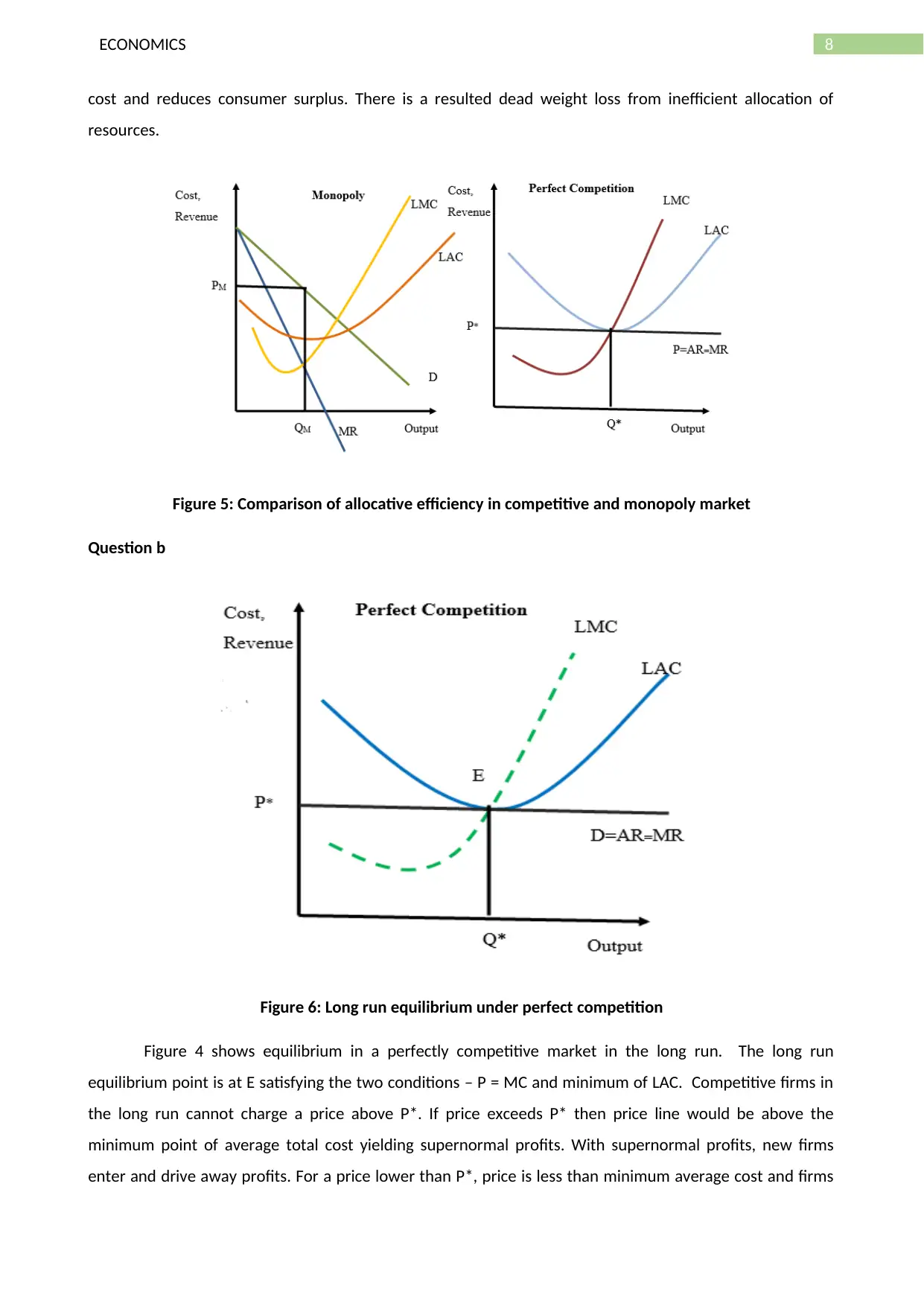
8ECONOMICS
cost and reduces consumer surplus. There is a resulted dead weight loss from inefficient allocation of
resources.
Figure 5: Comparison of allocative efficiency in competitive and monopoly market
Question b
Figure 6: Long run equilibrium under perfect competition
Figure 4 shows equilibrium in a perfectly competitive market in the long run. The long run
equilibrium point is at E satisfying the two conditions – P = MC and minimum of LAC. Competitive firms in
the long run cannot charge a price above P*. If price exceeds P* then price line would be above the
minimum point of average total cost yielding supernormal profits. With supernormal profits, new firms
enter and drive away profits. For a price lower than P*, price is less than minimum average cost and firms
cost and reduces consumer surplus. There is a resulted dead weight loss from inefficient allocation of
resources.
Figure 5: Comparison of allocative efficiency in competitive and monopoly market
Question b
Figure 6: Long run equilibrium under perfect competition
Figure 4 shows equilibrium in a perfectly competitive market in the long run. The long run
equilibrium point is at E satisfying the two conditions – P = MC and minimum of LAC. Competitive firms in
the long run cannot charge a price above P*. If price exceeds P* then price line would be above the
minimum point of average total cost yielding supernormal profits. With supernormal profits, new firms
enter and drive away profits. For a price lower than P*, price is less than minimum average cost and firms
⊘ This is a preview!⊘
Do you want full access?
Subscribe today to unlock all pages.

Trusted by 1+ million students worldwide
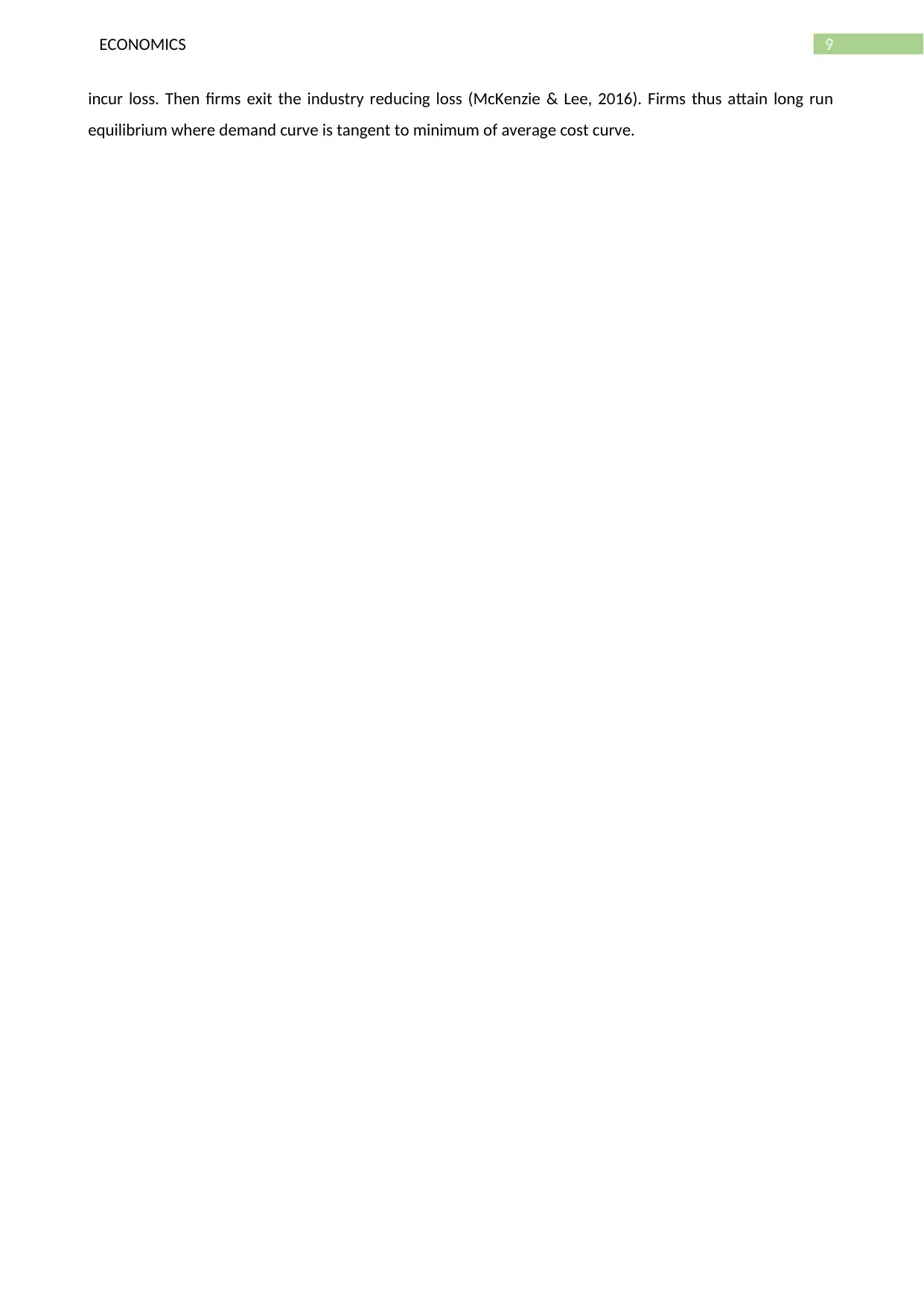
9ECONOMICS
incur loss. Then firms exit the industry reducing loss (McKenzie & Lee, 2016). Firms thus attain long run
equilibrium where demand curve is tangent to minimum of average cost curve.
incur loss. Then firms exit the industry reducing loss (McKenzie & Lee, 2016). Firms thus attain long run
equilibrium where demand curve is tangent to minimum of average cost curve.
Paraphrase This Document
Need a fresh take? Get an instant paraphrase of this document with our AI Paraphraser
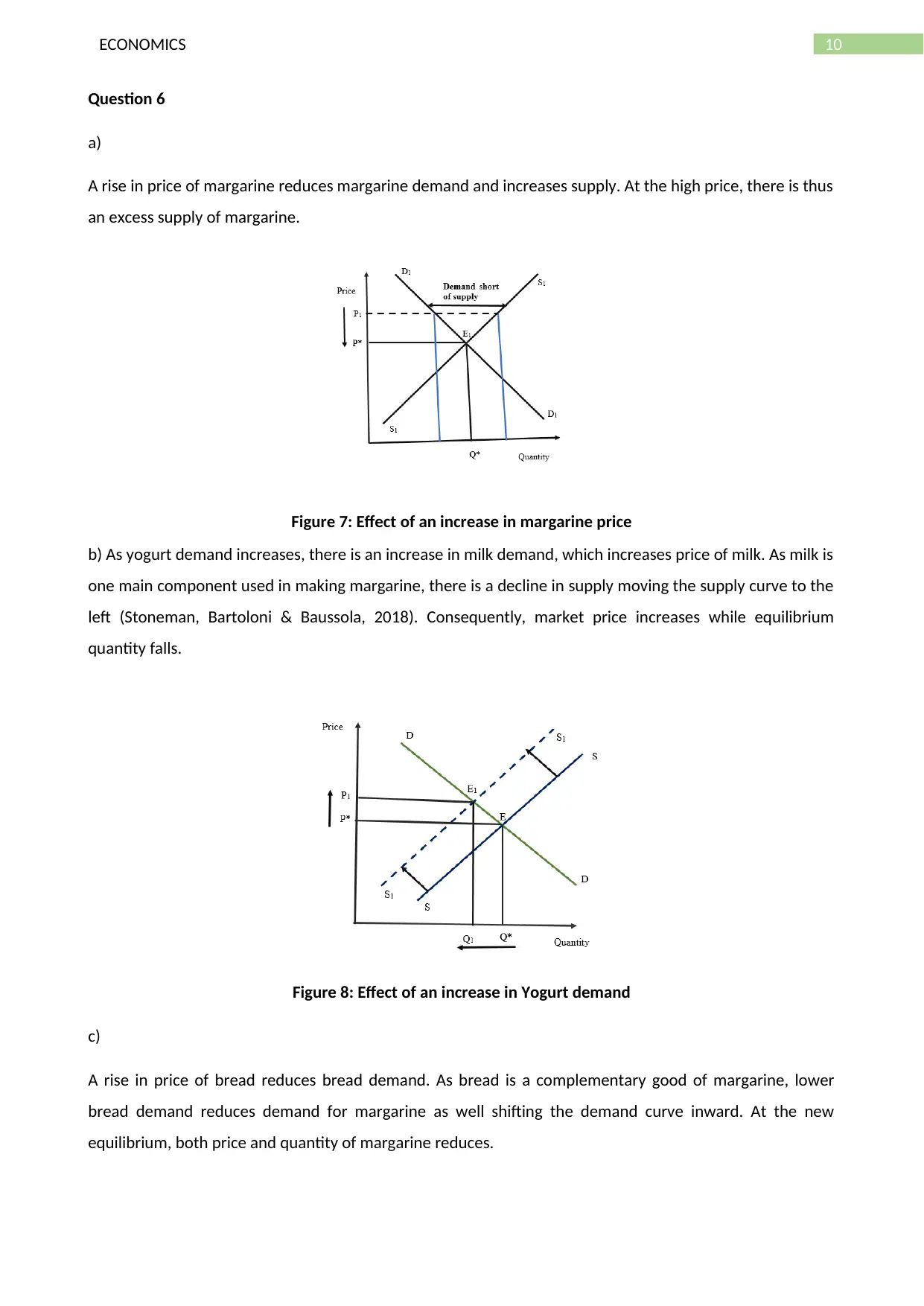
10ECONOMICS
Question 6
a)
A rise in price of margarine reduces margarine demand and increases supply. At the high price, there is thus
an excess supply of margarine.
Figure 7: Effect of an increase in margarine price
b) As yogurt demand increases, there is an increase in milk demand, which increases price of milk. As milk is
one main component used in making margarine, there is a decline in supply moving the supply curve to the
left (Stoneman, Bartoloni & Baussola, 2018). Consequently, market price increases while equilibrium
quantity falls.
Figure 8: Effect of an increase in Yogurt demand
c)
A rise in price of bread reduces bread demand. As bread is a complementary good of margarine, lower
bread demand reduces demand for margarine as well shifting the demand curve inward. At the new
equilibrium, both price and quantity of margarine reduces.
Question 6
a)
A rise in price of margarine reduces margarine demand and increases supply. At the high price, there is thus
an excess supply of margarine.
Figure 7: Effect of an increase in margarine price
b) As yogurt demand increases, there is an increase in milk demand, which increases price of milk. As milk is
one main component used in making margarine, there is a decline in supply moving the supply curve to the
left (Stoneman, Bartoloni & Baussola, 2018). Consequently, market price increases while equilibrium
quantity falls.
Figure 8: Effect of an increase in Yogurt demand
c)
A rise in price of bread reduces bread demand. As bread is a complementary good of margarine, lower
bread demand reduces demand for margarine as well shifting the demand curve inward. At the new
equilibrium, both price and quantity of margarine reduces.
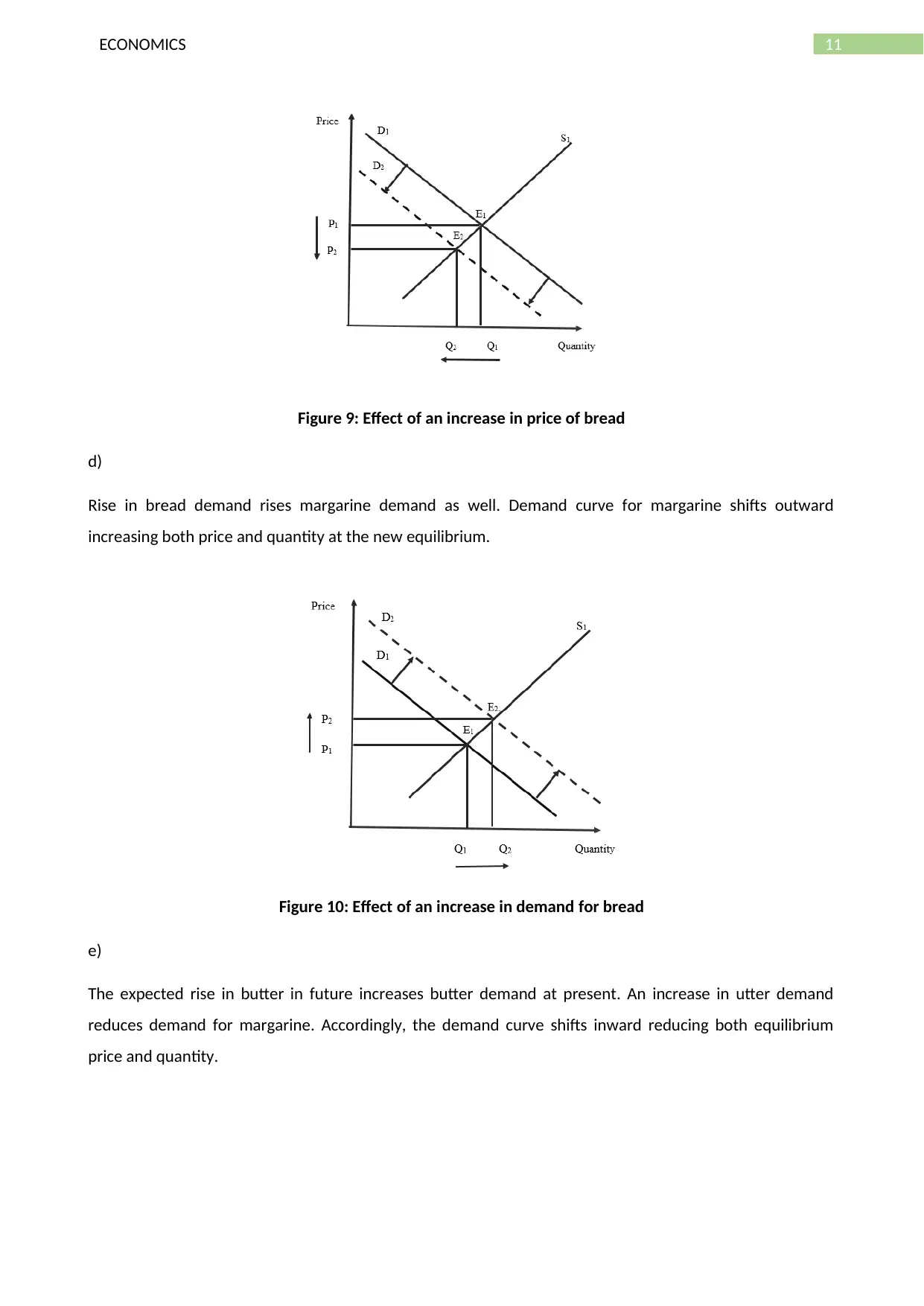
11ECONOMICS
Figure 9: Effect of an increase in price of bread
d)
Rise in bread demand rises margarine demand as well. Demand curve for margarine shifts outward
increasing both price and quantity at the new equilibrium.
Figure 10: Effect of an increase in demand for bread
e)
The expected rise in butter in future increases butter demand at present. An increase in utter demand
reduces demand for margarine. Accordingly, the demand curve shifts inward reducing both equilibrium
price and quantity.
Figure 9: Effect of an increase in price of bread
d)
Rise in bread demand rises margarine demand as well. Demand curve for margarine shifts outward
increasing both price and quantity at the new equilibrium.
Figure 10: Effect of an increase in demand for bread
e)
The expected rise in butter in future increases butter demand at present. An increase in utter demand
reduces demand for margarine. Accordingly, the demand curve shifts inward reducing both equilibrium
price and quantity.
⊘ This is a preview!⊘
Do you want full access?
Subscribe today to unlock all pages.

Trusted by 1+ million students worldwide
1 out of 16
Related Documents
Your All-in-One AI-Powered Toolkit for Academic Success.
+13062052269
info@desklib.com
Available 24*7 on WhatsApp / Email
![[object Object]](/_next/static/media/star-bottom.7253800d.svg)
Unlock your academic potential
Copyright © 2020–2025 A2Z Services. All Rights Reserved. Developed and managed by ZUCOL.




